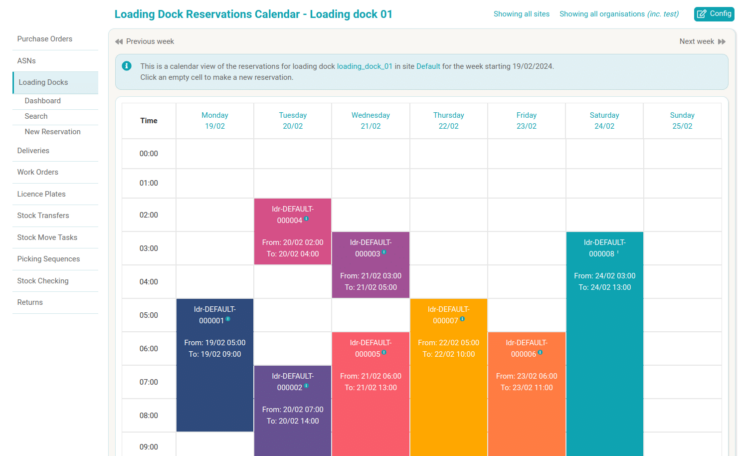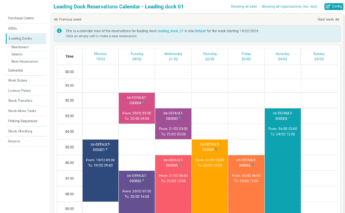We’ve also introduced a whole or part licence plate picking capability, useful for handling very large orders. Where an order line can be fulfilled using a whole pallet pick, this is achieved via a simple licence plate move. However, if the required quantity cannot be matched with a full pallet, then the user is prompted to just take what is needed. This provides the simplicity and efficiency of a whole licence plate move where this is possible, with the flexibility of a partial pallet pick where necessary.
From OrderFlow 4.3.9 it’s now possible to interleave stock check operations with an order or stock move task pick. The conditions under which the stock check is triggered can be controlled through scripting logic. For example, the check could be enabled for stock that had fallen below a threshold quantity since the last stock check took place. Once the stock check has been completed, the operator is directed to continue their pick.
We’ve improved the efficiency of our Shopify integration by allowing for sales orders to be fetched by fulfillment status, with an additional notification to Shopify to indicate that the previously fetched order has been ‘accepted’ onto OrderFlow. This change helps to eliminate much of the ‘noise’ previously generated from refetching orders already imported.
We’ve also enhanced our manufacturing works order functionality by allowing the picking and stock management operations for product labels and other consumables to be managed separately from component or raw material inputs. This is particularly important for food manufacturing, where the packaging and label stock needed for each works order often needs to be produced separately from its own stock holding close to the production area.
In addition to the features described above, we’ve added significant enhancements in multiple functional areas on the system.
Infrastructure and Security
In OrderFlow 4.3.9 we’ve added a number of upgrades to open source software libraries with the view to supporting Java 17, and in the near future Java 23, which are the most recent LTS (long term support) Java versions. All customer environments that are upgraded to OrderFlow 4.3.9 and above will also subsequently be upgraded to Java 17.
For our hosted customers we’re taking advantage of Amazon AWS to make it much easier to provide customers with SFTP-based file services, with customers able to access hosted files via SFTP (and other protocols if necessary). However, the underlying file storage will use AWS S3, which OrderFlow will access directly, which will make the setup and management of these services far easier.
The release introduces a mechanism to lock out users after successive failed logins. An administrator can unset this lockout as required. This complements AWS infrastructure changes that now apply rate-based rules to limit exposure to DDOS (Distributed Denial of Service) attacks.
We’ve also made changes to the OrderFlow reporting framework to ensure that scoping rules are always explicitly defined when creating custom reports. This change will help ensure that access to report data is always restricted to the intended recipients.
Stock Management
With the latest release we’ve added a change that restricts the move of order line location assignments when using the handheld MOVE LOCATION menu. The general rule is that assignments can be transferred when moving stock from one licence plate to another, or from one pickable storage location to another. Otherwise, only free stock can be moved from one location to another. This rule was previously being applied for individual product stock moves, but not whole location stock moves.
Product Management
At OrderFlow we are enthusiastic advocates of the use of GS1 standards where possible. In recent releases we’ve made a number of changes to extend the system’s behaviour in this area. With OrderFlow 4.3.9 we can now extract the GS1 GTIN (Global Trade Identification Number) from complex barcodes and use these both for product searches and for registering new barcodes on the system. We’ve also made it possible to identify a product by scanning a GS1 barcode label that begins with a SSCC (Serial Shipping Container Code) rather than the GTIN itself.
With OrderFlow 4.3.9, we’ve added a new feature which allows for operations involving the activation and deactivation of products to be captured and stored on the system.
Lot Tracking
With the most recent releases, we’ve added some enhancements to lot tracking functionality. Notable among these is improved visibility of expiry date information when searching stock stock records.
We’ve also allowed for a ‘pack size’ to be recorded against specific lots. This pack size represents the typical number of items or weight per unit received. For example, if the stock for a lot is received in 20 kg bags, this would be recorded against the lot itself. The pack size can then be used as a hint when capturing the quantity of stock being picked or put away.
Order Processing
With OrderFlow 4.3.9 we’ve introduced a new shipment splitting strategy that allows for back orders to be created from the order lines in a shipment that are not pickable (with specific pick locations already identified). Previously, the back order creation was only possible for lines that were considered out of stock (with insufficient stock present in the warehouse itself).
We’ve also made it possible to restrict package creation during the scan to pack operation to international shipments. For domestic shipments, it is often sufficient simply to indicate how many packages are required, without having to specify their contents during packing. For international shipments, where the weight and contents of individual packages is important for customs purposes, this level of control is more important, at the cost some operational overhead.
In the latest release we’ve made it possible to include shipment warnings in the import of sales orders. For example, a pack warning will involve a message that has to be explicitly acknowledged by the packer in order to complete the pack operation. This warning may be used to indicate to the packer that specific processing steps are required, or to perform extra checks if the order involves any hazardous items.
Other Enhancements
Since our last release announcement in October 2023 we’ve added nearly 200 enhancements and bug fixes.



